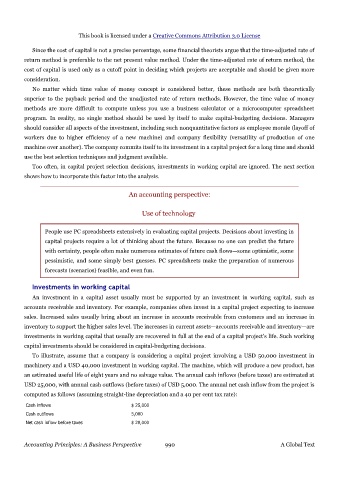Page 989 - Accounting Principles (A Business Perspective)
P. 989
This book is licensed under a Creative Commons Attribution 3.0 License
Since the cost of capital is not a precise percentage, some financial theorists argue that the time-adjusted rate of
return method is preferable to the net present value method. Under the time-adjusted rate of return method, the
cost of capital is used only as a cutoff point in deciding which projects are acceptable and should be given more
consideration.
No matter which time value of money concept is considered better, these methods are both theoretically
superior to the payback period and the unadjusted rate of return methods. However, the time value of money
methods are more difficult to compute unless you use a business calculator or a microcomputer spreadsheet
program. In reality, no single method should be used by itself to make capital-budgeting decisions. Managers
should consider all aspects of the investment, including such nonquantitative factors as employee morale (layoff of
workers due to higher efficiency of a new machine) and company flexibility (versatility of production of one
machine over another). The company commits itself to its investment in a capital project for a long time and should
use the best selection techniques and judgment available.
Too often, in capital project selection decisions, investments in working capital are ignored. The next section
shows how to incorporate this factor into the analysis.
An accounting perspective:
Use of technology
People use PC spreadsheets extensively in evaluating capital projects. Decisions about investing in
capital projects require a lot of thinking about the future. Because no one can predict the future
with certainty, people often make numerous estimates of future cash flows—some optimistic, some
pessimistic, and some simply best guesses. PC spreadsheets make the preparation of numerous
forecasts (scenarios) feasible, and even fun.
Investments in working capital
An investment in a capital asset usually must be supported by an investment in working capital, such as
accounts receivable and inventory. For example, companies often invest in a capital project expecting to increase
sales. Increased sales usually bring about an increase in accounts receivable from customers and an increase in
inventory to support the higher sales level. The increases in current assets—accounts receivable and inventory—are
investments in working capital that usually are recovered in full at the end of a capital project's life. Such working
capital investments should be considered in capital-budgeting decisions.
To illustrate, assume that a company is considering a capital project involving a USD 50,000 investment in
machinery and a USD 40,000 investment in working capital. The machine, which will produce a new product, has
an estimated useful life of eight years and no salvage value. The annual cash inflows (before taxes) are estimated at
USD 25,000, with annual cash outflows (before taxes) of USD 5,000. The annual net cash inflow from the project is
computed as follows (assuming straight-line depreciation and a 40 per cent tax rate):
Cash inflows $ 25,000
Cash outflows 5,000
Net cash inflow before taxes $ 20,000
Accounting Principles: A Business Perspective 990 A Global Text

